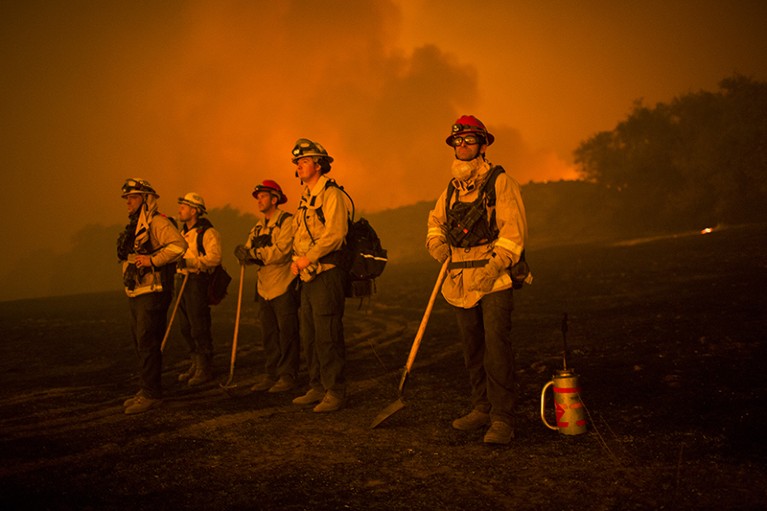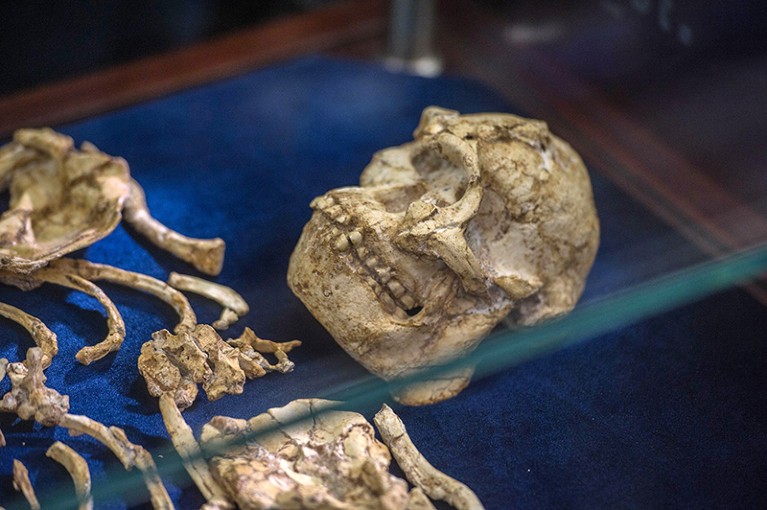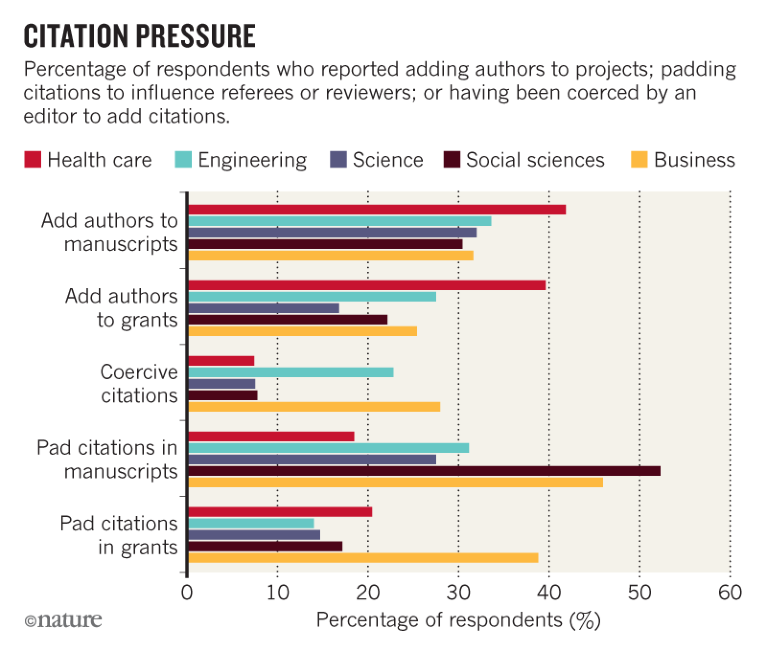ENVIRONMENT
California burning Fast-moving wildfires are torching the mountains around Los Angeles and San Diego, California, forcing the evacuation of more than 220,000 people. As of 11 December, the fires had burnt more than 103,000 hectares across Southern California and destroyed more than 1,000 structures. Wildfires are natural events in these hills, which are covered in vegetation called chaparral. But record-low humidity, months of extremely hot, dry weather and powerful Santa Ana winds — arid gusts that blow into the region from deserts east of Los Angeles — have resulted in explosive fire conditions. And because more people are living in these areas, wildfires pose a greater public-safety risk than they did decades ago.

Credit: David McNew/Getty
PEOPLE
Swedish misconduct Two Swedish scientists have been found guilty of “misconduct in research” in a 2016 study that they published in Science and later retracted. The highly publicized paper, by marine biologist Oona Lönnstedt and limnologist Peter Eklöv, both of Uppsala University, suggested that micrometre-scale particles of plastic in the ocean harm fish. An investigative board at the university announced on 7 December that both researchers had violated the regulations on ethical approval for animal experimentation. The board also found Lönnstedt guilty of having intentionally fabricated data. Eklöv told Nature he takes responsibility for the errors in the animal-ethics permit. Lönnstedt did not respond to Nature’s request for comment.
Volkswagen trial A former manager at carmaker Volkswagen was sentenced by a US court on 6 December to seven years in prison for his role in manipulating diesel-emissions tests. Oliver Schmidt, a German citizen who was in charge of environmental compliance for the company in the United States, had pleaded guilty to charges of conspiracy and violating the US Clean Air Act. He was tried in a federal court in Detroit, Michigan. Volkswagen admitted in 2015 that it had used software to lower nitrogen oxide emissions during lab tests of millions of diesel vehicles worldwide. The company and several of its top executives are still under investigation in Germany.
French agency chief Microbiologist Thierry Damerval was appointed as the next president and chief executive of the French National Research Agency (ANR) on 8 December. Damerval will leave his post as deputy director-general of the nation’s biomedical research agency, INSERM. His predecessor at the ANR, Michael Matlosz, resigned as chief in July, following widely reported discontent with the way the agency was being managed. The ANR has also had money troubles: despite an 8% increase in its budget to €643 million (US$757 million) in 2017, its funding is still less than it was in 2012.
EVENTS
Little Foot revealed The near-complete skeleton of one of the oldest hominin fossils ever found was unveiled in South Africa on 6 December. The specimen, dubbed Little Foot, has taken more than 20 years to excavate from a site in Sterkfontein. Ron Clarke, a palaeoanthropologist at the University of the Witwatersrand in Johannesburg who led the dig, considers the 1.3-metre-tall female to be a member of Australopithecus prometheus, but it will be formally described next year. Age estimates of the fossil — the most complete of its kind — range from 2.2 million to 3.7 million years old. Clarke says that the dig took so long because the fossils were removed from hard rock in situ, rather than being blasted out, which could have damaged them.

The Little Foot fossilized skeleton.Credit: Mujahid Safodien/AFP/Getty
French grants The government of France has announced the first awards in a research programme to lure international scientists to the country with grants of up to €1.5 million (US$1.8 million) over 3–5 years. President Emmanuel Macron introduced the initiative in June, shortly after US President Donald Trump said that he would pull the United States out of the 2015 Paris climate agreement. On 11 December, the French government revealed 18 recipients — including 13 from the United States — in the fields of energy, Earth sciences, and climate change and sustainability. France and Germany plan to partner on a second awards round in 2018.
FACILITIES
Pathogen lab The National Emerging Infectious Diseases Laboratories (NEIDL) at Boston University in Massachusetts has received final approval to open a high-security lab designed to contain dangerous pathogens such as the Ebola and Marburg viruses. On 6 December, Boston’s public-health commission approved the project — the last of numerous regulatory agencies to do so. NEIDL’s facility will now be upgraded to biosafety level 4, the highest level of containment. It will be one of only ten such facilities in the United States, and one of only two at universities there.
Fusion milestone Construction of the world’s largest nuclear-fusion experiment has passed the halfway mark. The ITER project said in a statement on 6 December that it has completed 50% of the construction work needed to achieve its initial goal: generating a superheated plasma of hydrogen, inside a doughnut-shaped magnetic cage, by 2025. Demonstration that ITER can generate significantly more energy through fusion than it uses to heat up its plasma is expected in 2036. The US$22-billion international project is more than a decade behind schedule, but it has so far stuck to a timetable introduced after current director-general Bernard Bigot took over in March 2015.
Brain initiative Brain researchers from the United States, Europe, Japan, South Korea and Australia announced on 7 December the creation of a global initiative to map and understand the brain. Inspired by global ‘big science’ projects in astronomy and genome sequencing, the International Brain Initiative aims to bring existing national-level projects into closer collaboration with data-sharing platforms and large-scale facilities for computation and brain mapping. The project’s ten-year goal is to provide a unified, evidence-based theory of brain function and the neural bases of cognitive processes. Its first meeting is planned for May 2018, in South Korea.
Translational centre Chengdu University in China has started construction on a US$200-million facility to help therapies move into the clinic. The National Center for Translational Medicine is designed to accommodate 2,500 scientists, including 500 working on drug discovery. It will be affiliated with the West China Hospital, one of China’s largest hospitals, with some 5 million patient visits a year, and Sichuan University, where researchers were the first to inject people with cells modified using CRISPR–Cas9 gene-editing tools. In addition to gene editing, the centre will focus on gene therapy, vaccines, immunotherapy, precision medicine and regenerative medicine. It will be one of five translational centres through which China hopes to develop cutting-edge medical techniques.
CONSERVATION
Monument changes US Secretary of the Interior Ryan Zinke recommended major reductions and management changes to protected areas on land and at sea in the United States, in a 5 December report. Several of these national monuments could be opened to industrial and commercial uses, such as coal mining or fishing. These include three protected areas in the Atlantic and Pacific oceans where commercial fishing is currently banned or being phased out. Zinke called for size reductions to four monuments in total; US President Donald Trump has already taken executive action to shrink two of them, in Utah. Native American communities and environmental groups are challenging the changes in federal court.
BUSINESS
Patent battles On 6 December, two new patent challenges were filed against the maker of the hepatitis C drug sofosbuvir in the United States, where a three-month course of the pills can cost US$84,000. The Initiative for Medicines, Access & Knowledge (I-MAK) in New York City filed six other challenges against Gilead Sciences of Foster City, California, in October. If the patents are overturned, I-MAK claims, a generic version of the drug could enter the US market years earlier, giving more than 2.7 million people with hepatitis C access to an affordable cure. Argentina rejected a patent on sofosbuvir last week, and China did the same in 2015. Patent lawsuits are pending in Brazil, Russia, Thailand and Ukraine.
TREND WATCH
Surveys of more than 12,000 scholars in 18 disciplines reveal how often they manipulate authors and citations in papers and grants. Respondents were asked if they had ever added authors whose scientific contribution was minimal, or padded reference lists with superfluous citations — either voluntarily to boost publication chances, or because an editor had asked them to do so (known as coercive citations). The researchers say the results reveal “widespread misattribution”.

Source: E. A. Fong & A. W. Wilhite PLoS ONE 12, e0187394 (2017).






